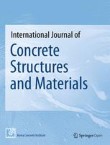International Journal of Concrete Structures and Materials is affiliated with Korea Concrete Institute.
Bond Strength of GFRP Bars Embedded in Engineered Cementitious Composite using RILEM Beam Testing
This paper presents a study on the bond characteristics of glass fiber reinforced polymer (GFRP) bars in engineered cementitious composite (ECC). Ninety beam specimens having variable parameters namely bar dia...
